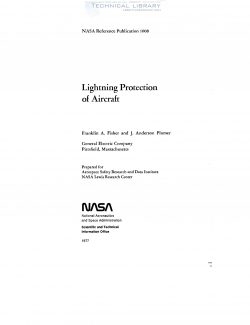NASA-RP-1008
- Version
- 517 Downloads
- 16.35 MB File Size
- 1 File Count
- March 7, 2017 Create Date
- March 7, 2017 Last Updated
NASA Reference Publication - Lightning Protection of Aircraft

This book is an attempt to pr&nt under one cover the current State Of knowledge concerning the potential lightning effects on aircraft and the means that are available to designers and operators to protect against effects. The impetus for Writing this book springs from two increased use of nonmetallic materials in the Structure of aircraft and the constant trend toward using electronic equipment to handle flight-critical control and navigation functions. NonfiEtallic Structures are inherently more likely to be damaged by a lightning strike than are metallic structures. Nonmetallic structures also provide less shielding against the electromagnetic fields of lightning than do metallic structures. These fields have demonstrated an ability to damage or Cause up*t of electronic equipment. Such concerns, When added to the continuing apprehension regarding the vulnerability of fuel systems to lightning, have led in the past dewde to increased research into lightning effects on aircraft. The results of this research are contained in the technical reports and literature published by ourselves and by researchers in other laboratories who are also working on these problems. Conferences and symposiurtb have been held so that researchers could exchange ideas and information; there is a high degree Of cooperation among all of those Working towards the goal of complete safety-of-flight in the lightning environ- menl. The persons who can best use information on aircraft protection from li$ltning are the aircraft designers and operators, but generally they are not among those Who produced this information. Moreover, they are often unaware of its existence, they seldom have the background to distill from it the important facts that can and should be applied 10 achieve safer designs. The purpose Of this book is to present the most important parts of this body Of knowledge in a manner most useful to the designer and the operator _ nis book is organized into seventeen chapters. In the first of these we review what lightning is and how it originates. The second chapter describes how the aircraft becomes involved with the lightning flash and why it is that aircraft do not produce their own lightning flashes, but may, we think, sometimes trigger natural ones. Chapter 3 considers how often and under what conditions aircraft have been struck, reviews avoidance procedures now in use by operators, and reviews their degree of success. We also take up the question of whether Or not strikes could be totally avoided. fourth chapter summarizes the various effects which have occurred when lightning has struck aircraft, giving the operator an idea Of the direct and indirect effects which he may expect when his ircraft is "zapped." Since our main purplR is 10 help the designer protect against those effects that may be hazardous, the remainder of the book is devoted to this purpose. Chapters 5, 6, and 7 deal with protection against the direct physical damage effects. Chapter 5 Forth three philosophical Steps which guide us in the design work that follows. Attention is also called to government standards or
| File | Action |
|---|---|
| NASA-RP-1008 Lightning Protection of Aircraft.pdf | Download |

Comment On This Post